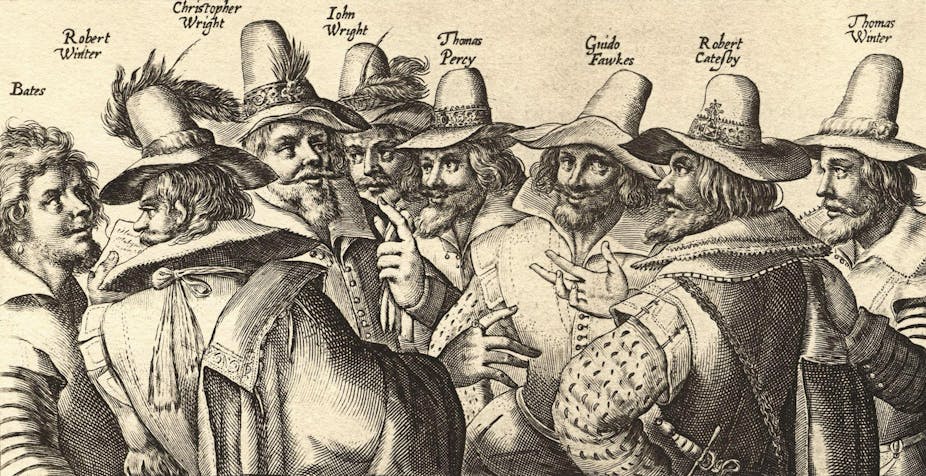Bristol Old Vic is currently coming to the end of its run of a new production of Arthur Miller’s classic play The Crucible, a dramatisation of the Salem witch trials that occurred in New England towards the end of the 17th century. Directed by Tom Morris, famous for War Horse, this is a solid production, with excellent performances from both Dean Lennox Kelly and Neve McIntosh as John and Elizabeth Proctor.
First performed in January 1953, The Crucible has long been considered a consummate expression of anti-McCarthyism – a thinly–veiled allegory of the communist “witch hunts” that soured America during the post-war period. And it’s fitting that at this time of year our thoughts should turn to witch hunts once again.
In 1605, Guy Fawkes was discovered in a cellar in the Houses of Parliament, checking on the gunpowder kegs that had been left there ready to unpleasantly surprise the King, James I. Although Fawkes wasn’t the ringleader, he was caught redhanded; and although torture was technically illegal at the time, King James provided special written authority to proceed with tortures ranging from the “most gentle” to the “worst”.
After days of undisclosed agony, Fawkes confessed, leading to the pursuit and incidental death of Robert Catesby, the actual ringleader. Fawkes, along with some others, was sentenced to be hung, drawn and quartered.
Fawkes was considered fortunate to break his neck during the hanging and so was dead prior to being disembowelled. But for 400 years, Britons have felt it incumbent upon themselves, once a year, to burn effigies of Fawkes on bonfires, with or without an attendant chorus of fireworks.

Penny for the Guy
When I was a child – back in the 1980s – the “penny for the Guy” tradition was commonplace. For those who don’t know, this meant stuffing a set of old clothes with screwed up newspaper and rags until it resembled a human form. In the run-up to Bonfire Night, the “Guy” would be wheeled about on a small, home-made cart or other contraption by children asking for a “penny”. Finally, poor Guy would go up in flames. Again. And again.
The annual bonfires survive, but in recent years, the tradition of the “Guy” seems almost entirely to have died out. It’s difficult to pinpoint the reason why. It would be easy to blame video games and social media for its loss of appeal, but the enduring popularity of Bonfire Night and, increasingly, Halloween suggests there is still an appetite for similar traditions.
But Bonfire Night and Halloween are linked by more than just calendrical proximity. The Gunpowder Plot occurred against a background of religious persecution, suspected witchcraft, and plague. Protestant King James was highly preoccupied by both religion and witchcraft, and was the author of – amongst other writings – Daemonologie, which might be described as a treatise on witch-hunting. James’s personal writings frequently equated Catholicism with satanism, and in some parts of the country effigies of the Pope and Satan have traditionally been burned along with the Guy.
To put it into context, The Gunpowder Plot took place in 1605; Macbeth was written in 1606; the King James Bible appeared in 1611; and the famous Pendle witch trials in 1612. Guy Fawkes not only represented treason, but also Catholicism and, by implication, devil worship. It’s not difficult to perceive a link between Halloween’s outing of witches and warlocks and, a few days later, the ritual burning of satanic evil. Bonfire Night represented a purging of all society’s ills – a sort of mob bloodletting.

Exorcising our demons
Which brings us back to The Crucible. Miller wrote the play at the time of the Rosenberg trial – the couple notoriously executed for passing atomic secrets to the Soviets; colluding with the devil himself. It’s very easy to draw parallels between Guy Fawkes and the Rosenbergs. All were executed, in spectacular and public fashion, for the crime of treason. All have been somewhat cast as scapegoats. And all their stories were played out against a backdrop rich with the tapestries of witch-hunting, as fearful societies attempted to exorcise their figurative demons.
But within the text of The Crucible, there is nothing to suggest we are reading a critique of anticommunism. If we were to confine our understanding to the play itself, rather than the secondary commentaries that have tended to dominate our understanding, we would find that the true source of both the witchcraft and the accusations (and, by extension, the hangings) are pubescent and pre-pubescent girls.

Led by Abigail Williams (played superbly in the BOV production by Rona Morison), these uncannily powerful girl-children hold the locus of control entirely. Uncomfortably, everything pivots on pubertal female sexual desire and revenge. What we are left with, in the end, is a play where the source of the “evil” comes not from Big Government but from small children: specifically, pubescent girls with more or less explicit sexual intent.
This renders the play far less digestible than a one-size fits all commentary on McCarthyism. And that this has been so consistently sidestepped by commentators should give us room for pause, since the scapegoat mechanisms of witch hunts are situated precisely in our reluctant inability to see ourselves. We prefer instead to project that which makes us uncomfortable onto another, sacrificial victim. It’s much easier to point the finger knowingly at McCarthyists or “ignorant” villagers than to dwell on some of the very complex issues raised by Miller’s play, issues that still have the power to trouble us in 2015, just as they did in 1953 and in 1605.
Penny for the Guy, anyone?

